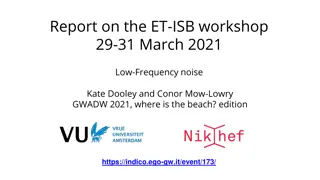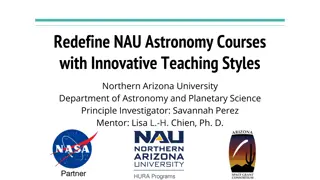Unveiling the Fascinating History and Science of Gravitational Wave Astronomy
Delve into the intriguing world of gravitational wave astronomy, from Einstein's initial predictions in 1916 to the recent breakthroughs in detecting these elusive waves. Explore the generation of gravitational waves, their impact on matter, and the key players in unraveling the mysteries of the universe.
Download Presentation

Please find below an Image/Link to download the presentation.
The content on the website is provided AS IS for your information and personal use only. It may not be sold, licensed, or shared on other websites without obtaining consent from the author.If you encounter any issues during the download, it is possible that the publisher has removed the file from their server.
You are allowed to download the files provided on this website for personal or commercial use, subject to the condition that they are used lawfully. All files are the property of their respective owners.
The content on the website is provided AS IS for your information and personal use only. It may not be sold, licensed, or shared on other websites without obtaining consent from the author.
E N D
Presentation Transcript
Gravitational Wave Astronomy Nigel T. Bishop Department of Mathematics Rhodes University
History Einstein predicted GWs in 1916 Quadrupole formula, which relates GWs to matter sources, derived in 1918 Debate for the next 40 years about reality of GWs Issue: In general relativity, there are no preferred coordinates
y y= y + sin (2x) x x = x B A B A
1930s Einstein concluded that GWs are not physically real, and submitted a paper to Physical Review Referee said the paper was wrong Einstein replied: We (Mr. Rosen and I) had sent you our manuscript for publication and had not authorized you to show it to specialists before it is printed. I see no reason to address the - in any case erroneous - comments of your anonymous expert. On the basis of this incident I prefer to publish the paper elsewhere
1930s Einstein submits to Journal of the Franklin Institute At proof stage, Einstein realized the error and corrects paper before publication
1950s Wave-like solutions to the Einstein equations that are transverse to the direction of motion, cannot be transformed away en.wikipedia.org
These waves can transfer energy to other matter: ring on a stick with friction (Feynman 1957)
How are GWs generated? Einstein s quadrupole formula: relative motion of matter Efficient generators are very dense Neutron stars Black holes and relative velocities are large Final stage of neutron star / black hole mergers
Earth 150 million km Sun Mass of Sun = 1 M = 2 x 1030 kg= 1.5 km
Distant galaxy Nearby star 1 pc = 3 x 1013 km 1 000 Mpc Sun 8 000 pc 1 Mpc = 3 x 1019 km Galactic centre Nearby galaxy
Black hole Neutron star 30 km 60 km and larger Nothing, not even light, can escape Mass 10 M and larger Mass 1.4 M Supernova remnant
Most galaxies contain a supermassive black hole Usually 106 to 107 M Can be up to 1010 M For our galaxy, it is 4 millionM
Generation of GWs Two equal mass stars in circular orbit
Magnitude of GW is ?? ? ????? 2 2 (? ?) ? Twice orbital frequency Less than 1, but maximized for 2 black holes at merger Typical value of M is 10 M = 15 km Typical values of r Nearby star 3 1013 km In our Galaxy 3 1017 km Neighbouring galaxy 3 1019 km
Observational evidence for GWs: PSR1913+16 Two neutron stars, each about 1.4 M , in eccentric orbit Period of orbit: 7.75 hours Period of pulsar: 59 ms GW emission causes orbit to shrink, and period to decrease
Detection methods: Resonant bars 2 tonne aluminium cylinder, cooled to 1 K ( ~ - 272 C ) v v 1m 2m Method pioneered by Joseph Weber in 1960s. GW causes tidal distortion in the bar, leading to vibrations which are measured.
Detection methods: Pulsars Pulsars are highly accurate clocks, beating at up to 103 Hz Measure received pulse times on Earth Irregularity due to GWs But pulsars can glitch, so requires data integrated over 5 to 10 years An important task for SKA Gravitational Wave Astronomy Group, Penn State, http://www.gwastro.org/for%20scientists/gravitationa l-waves-and-pulsar-timing-asia-earth
lisa.jpl.nasa.gov/gallery/lisa-waves.html Mission delayed until at least 2028
Detection methods: LIGO LIGO: Laser Interferometer Gravitational Observatory First generation detectors, from 2001 LIGO (Hanford, USA; 4 km) LIGO (Livingston, USA; 4 km) Virgo (Italy; 3 km) GEO (Germany; 0.6 km)
Advanced LIGO detectors Approved Hanford, USA, completed 2015 Livingston, USA, completed 2015 VIRGO, Pisa, Italy, completed 2017 LCGT, Japan, completed 2019 INDIGO, India, scheduled completion 2022 Locating a source in the sky, i.e. to do astronomy, requires at least three detectors to triangulate via timing.
LIGO data analysis Likely that signals will be masked by detector noise, and will be found later Example: Does this data contain a sinusoidal signal at 10Hz? ? ? =2 ? ?=1 sin 20????(??) = 0.05
Even negative results can be useful: Pulsar at centre of Crab nebula does not have a mountain higher than 1 metre
Last days of inspiral and merger of 2 black holes at 100 Mpc, each 20 M Limit of validity of quadrupole formula Einstein s quadrupole formula assumes speeds much less than that of light, but this does not apply just before merger of compact objects How do we calculate the signal near merger, when it is detectable?
Merger requires solution to full Einstein equations Spacetime simulated by computer, but each run can take months Simulation must be highly accurate
Example of a merger waveform (Reisswig, Bishop & Pollney 2010)
Video of merger of equal mass binary black holes (Max-Planck Institute for Gravitational Physics) http://numarch.aei.mpg.de/numrel- webpages/movies/moving_punctures_AEI.mov
Video of black hole merger resulting in a kick (Rochester Institute of Technology) http://ccrg.rit.edu/movies/numerical-relativity/2- black-hole-merger-kick Kicks are usually about 300 km / s, but can be as large as 3 000 km /s, which would eject the remnant from its galaxy
Sound of GWs LIGO is more like an ear than an eye Spinning neutron star Supernova Merger of two neutron stars Merger of two 10 M black holes Merger of two 50 M black holes ( http://www.black-holes.org/explore1.html and http://gmunu.mit.edu/sounds/comparable_sounds/comparable_ sounds.html )
Astronomy Merger rates: populations of black holes, neutron stars Black hole / neutron star binary: Size, and so the composition, of a neutron star Black hole mergers are standard sirens, so can measure the Hubble constant Test GR and other alternative theories
and also Insights that only GW observations can provide Gravitational wave propagation speed And a view of hidden interiors Gamma ray bursts, from compact object coalescence? Supernovae: mechanism in the interior direct observations of the
LIGO in South Africa Site selection study at Hartbeeshoek Radio Astronomy Observatory Flat topography Low seismicity Far from sources of noise or vibration
Source localisation: with and without India, Japan, South Africa S Fairhurst (2012)
Protected zone preferred AGAP zone Source:SKA
Conclusion What is the effect of GWs? How can GWs be detected? What causes GWs? How can GWs be calculated? What will GWs tell us about the cosmos?
Since we have a new window to the cosmos, expect The Unexpected!























